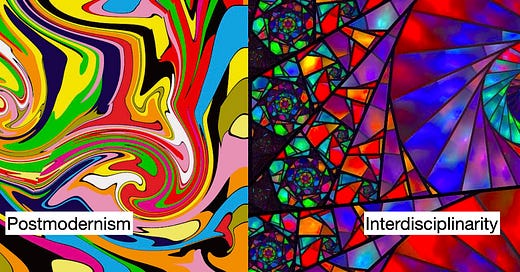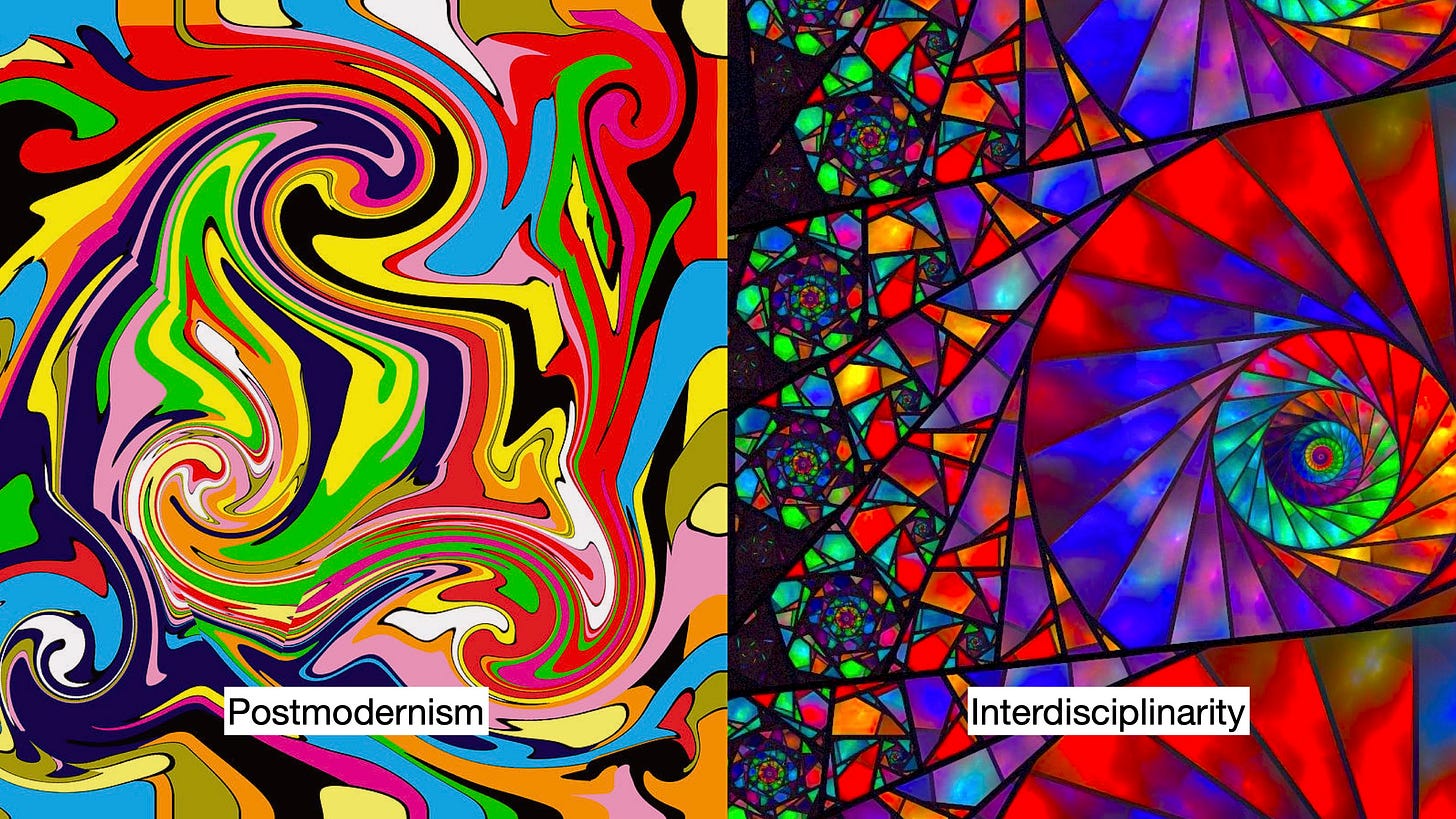I will preface this article by saying that it’s an amalgamation of my own personal thoughts on concepts that I’ve learned at the London Interdisciplinary School. Don’t take my work as fact or as an assertion, instead think of it more as a personal journal entry.
For anyone who did not spend the last three years tackling complex problems and researching interdisciplinary topics, the word Interdisciplinarity might mean nothing at all to you. Others might relate it to disciplines like geography or art.
In simplest terms Interdisciplinarity is a type of paradigm, an all encompassing worldview of how we understand and process the world around us which exists on the crossroads of three ideas: intentionality, integration and complexity.
When a boy first learns to speak, walk, and play, without having the baggage of adult–life, the amount of boundaries and categories of things in his mind is quite limited. He can see a toy-truck as a “toy” or as a real life truck. But he can also see a bundle of sticks as a real truck.
He can switch from playing restaurant to playing tag in a moment’s notice. He can mix up words or even start speaking in incoherent ways. For the child our philosophical, social and scientific boundaries do not yet exist. He lives in a pre-modern world, where day-by-day boundaries are being slowly introduced.
Then, as you grow, you start to learn about different disciplines in school. You learn about different professions that are often used to characterize people. You learn about different religions, ethnicities, nations, companies… effectively you learn about categorization.
Categorization helps us understand what connects things. As well as the idea of differences/similarities between various concepts.
Then the weirdest thing happens, since there are way more ideas about the world than there is time to research them, people start to gradually form mental models of the world based on a limited number of categorical perspectives. Our reality becomes that which we encounter most often. This is called a silo.
Siloes are a phenomenal achievement of modernity. We have created individuals who spend their whole lives, researching single unique types of butterflies, others learn to break apart the atom, some can design a spaceship, others build skyscrapers.
Categorization plus time gave us specialization. The limitless nature of our world caused the aspect of specialization to broaden siloes so far that a single discipline can ‘in theory’ explain anything and everything. One person can view the world from the perspective of mathematics, while another can view the world from the perspective of literature.
For this essay to bring the point home, let’s put aside the idea that “the world is becoming more interconnected than ever before”. Because frankly that is irrelevant, if the depths of knowledge are ever increasing, and they are all increasing in orthogonal directions to each other, then even if the world wasn’t more interconnected we would still see an increase in division and misunderstandings.
The existence of these siloes of knowledge paired with a limitless amount of intellectual free time will, given enough time, always cause the unintentional birth of new complex problems.
So how do we deal with an ever increasing divide between the various siloes of knowledge?
Postmodernists believe that the walls between siloes should be broken down. That the idea of a discipline is “fake”, human-made, and doesn’t represent reality truly. Just as the image of the atomic model taught in schools doesn’t in anyway accurately represent a real atom.
Interdisciplinarity on the other hand, believes that the siloes are important. It views them as raw material that can be used to build a better picture, a better representation of the world. To understand the world, humanity had to break the world into pieces; Interdisciplinarity aims to use those pieces to form a mosaic picture of reality.
Intentionality
We now come onto the first concept that underpins Interdisciplinarity. Intent, is by far one of the most important parts of the process. You have to be able to intentionally choose to let go of your pre-set perspectives, let go of your cognitive and intellectual biases.
Let’s say you’re looking at the topic of the housing crisis in England It may be biased to think that economics is the cornerstone that underpins the whole problem. As an Interdisciplinarian your goal is to intentionally set that bias aside, and look at the problem from a variety of other disciplines. Research the topic across all fields and if possible, other languages. Intentionally find the connections, trend-lines and causal relations as effectively as possible between the disciplines and the problem. For the housing crisis example take a look at sociology, politics, design, business and geography to name a few.
Make it clear, in your writings and during the process of your work that you are in an interdisciplinary mindset, aiming to understand the problem at hand. Allow yourself to wear the hat of a Landlord and a tenant. The builder and the construction site manager. The local government official and the holding company CEO.
Intentionally, take information from each silo that you’ve found to be heavily connected to the problem. The intention to pick what quantitative needs of data and knowledge you may have, as well as the qualitative in terms of your research, clearly understanding that you are taking pieces from disparate siloes and attempting to glue them together. You intentionally acknowledge the boundaries, and you intentionally acknowledge the potential connections, your biases and strengths.
An Interdisciplinarian must recognize their own potentials of intentionality to understand how to interact with the emergent collective intentions of social groups and complex problems, for kin senses kin.
Integration
The next step to understanding Interdisciplinarity comes from what we call integration or synthesis. To me the two terms are one and the same, and I will use them interchangeably. (Some may disagree, but in terms of pragmatics they’re effectively the same)
If you go to a fusion restaurant in London and order a pizza with a side of sushi rolls that would be the equivalent of multidisciplinarity. An Italian food served next to Japanese food. Yet that would not be an apt metaphor for Interdisciplinarity.
Now if you go to Toronto, Canada and order their infamous Sushi Pizza. Then you would get something that is the result of integration. In this case a ridiculous and one might argue bad, yet apt metaphor.
A good example of integration is that of a Mixed Martial Arts fighter who intentionally employs combinations of moves from various fighting styles.
Now let’s take it a step higher.
Let’s say you are building the hull for a submarine and are trying to create an effective aqua-dynamic hull surface. You start off in the discipline of engineering. You then look at chemistry and physics and eventually synthesize your goals and your research into a field called material science. Now maybe what you come up with isn’t enough. A good Interdisciplinarian should train to always broaden their interests and look at the same problem from not just other angles but other perspectives.
How does a fish move so easily through water? You run with that question and integrate engineering or material science with zoology and now you’ve synthesized biomimetics, the field that aims to replicate biological systems in technology. Broaden your horizons: look into geology, look into some obscure research done by other governments and companies. Take in some concepts from aero-dynamics. Etcetera.
Some ideas will work, others will prove to be useless. Don’t jump the gun, instead immerse yourself in the process of research and integration.
Complexity
Ah yes. The moment when the geneticist has to explain how DNA functions, the theologian has to define what God is, the evolutionary biologist has to prove speciation, and the physicist has to explain why special relativity works. So comes the moment when an Interdisciplinarian has to define complexity; simultaneously the bane and the reason of our existence.
Let’s start with the notion of a simple system. Like baking a cake. We know the ingredients, we know the temperature, we even know that different cooks may be using different ovens in different humidity levels. At the end of the day, if we put in enough effort we can produce a perfect recipe where every single time (bar human error) we’ll get the exact same cake.
We know the unknowns, we know where mistakes can happen and the process is quite linear.
Now we move onto ‘complicated’ systems. For example, flying to space. We know how to build a spaceship, we also know how to recalculate in case the weather changes unexpectedly. But nonetheless due to the vast number of parts in the process, and certain unknowns being unexpected such as solar flares or unexpected reactions of metals in space for example a high-gain antenna failed due to cold-welding issues on the Galileo spacecraft (Or Human Error). We can learn the process and overtime become better at it. But if we change it, even slightly things can become once again unexpected.
We know many of the unknowns but not all, the process can be made linear if repeated many times, and with experience we can have a good level of certainty that things will go as planned.
Now we move on to our infamous friend complexity. In complex systems the parts of the system aren’t always linear. They can be codependent. For example if a marriage is falling apart. It could be as simple as one half of the marriage is unhappy. But if you were to make that person happy then the other half might become unhappy as a result.
If that couple decides not to have kids they may be happy for five maybe ten years. But if they wait too long they might become miserable. Or, they might not. You just don’t know.
They may be having problems because one of their relatives is whispering negative thoughts in the ear of one of them. Yet, maybe, that person chooses not to divulge that information.
Another problem is that as you gather data, the data changes. So data from a year ago could become irrelevant tomorrow. And worse of all if you intervene, your intervention may become the thing that makes the marriage unsalvageable!
Not only do we not know all of the unknowns, but the unknowns are changing. And they could be changing because we are inquiring about them.
What makes complexity so intriguing is the fact that it is intrinsically tied to the human condition.
Here are some criteria that make a system ‘complex’:
It exists on the edge of chaos, just like a small burning patch of dry grass is on the edge of becoming an unstoppable forest fire. It can be quite sensitive to initial conditions.
It has adaptive properties. How a bee hive adapts when the queen dies, completely altering their collective behaviour.
It is non-linear, like monetary policy whereas printing too much currency can impact the direction of trade and the value of goods which in turn can impact the currency again starting a feedback loop that can render certain countries economically bankrupt.
It exhibits signs of emergence, like the emergence of new art-styles when artists create together.
An intervention in a complex system is often irreversible and changes the system, for example Artificial Intelligence regulation changes the course of AI development and can in theory be the cause of both protection or potential hindrance by AI.
Now when a problem exhibits the features of a complex system we call that a wicked problem. It is wicked because we never truly know when it is solved, we never truly know if we’ve understood it fully, and we usually only get a single limited-in-funding-and-time attempt at tackling it. I will make a separate post on Wicked Problems altogether, for these are hard to tame beasts.
And it’s for this exact reason that Interdisciplinarity is needed. A siloed bunch of specialists can solve space travel. But you need interdisciplinarians if you are to tackle large social problems. The solution to something like the housing crisis isn’t only mathematical, economical, business-oriented, sociological or governmental. Most likely the solution is somewhere in between.
So what is Interdisciplinarity? Well in simplest terms Interdisciplinarity is a type of paradigm, an all encompassing worldview of how we understand and process the world around us by broadening our horizons, forming connections, merging distant ideas and seeing things for what they are - complex.
It is a pragmatic reaction to our problems. When the world seeks answers why not turn to interdisciplinarity?






